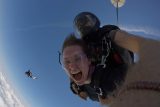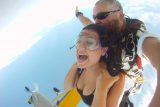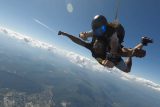Tandem skydiving is the most popular way to experience skydiving for the first time. Strapped to a qualified instructor, you’ll exit the plane together and enjoy freefall for around a minute before your parachute opens. As easy as that sounds, it’s natural for many people to wonder how much risk is involved when making a tandem skydive. Below we’ve put together some information on the statistics of skydiving safety and explain why tandem skydiving is now safer than ever.
USPA Statistics on Tandem Skydiving Safety
The USPA (United States Parachute Association) is the governing body for the sport of skydiving here in the US. As well as overseeing the safety guidelines for skydiving, the USPA also tracks the number of incidences over time and reports on those statistics.
The most up to date statistics come from 2014, when the USPA recorded 24 fatal skydiving accidents. There were 3.2 million jumps in total that year, making for a total of 0.0075 fatalities per 1,000 jumps.
Tandem skydiving has an even better safety record, with 0.003 student fatalities per 1,000 tandem jumps over the past ten years.
Statistically, tandem skydiving in the US is the safest it’s ever been, thanks to the vigilance of skydivers and the guidance of the USPA.
Tandem Skydiving Instructor Ratings
Skydivers who want to become tandem masters must have a minimum of three years in the sport and 500 completed jumps before they can be considered for their tandem instructor rating. They are then required to complete a series of evaluations and exams to achieve their USPA approved rating.
This means when you make a tandem skydive in the US, and you do so at a USPA approved drop zone, you can rest assured that you’re in safe hands.
The Technology of Tandem Skydiving
The technology of skydiving, in general, has evolved over the years. We’ve made changes and additions to our equipment to keep us safer. Tandem skydiving is no exception and technological advances here have led to the sport being safer than ever.
As with all forms of skydiving, tandem skydivers jump with two parachutes; a ‘main’ parachute and a ‘reserve’ parachute. This ensures that, should the first malfunction in any way, there is a second backup.
We also use an automatic activation device (or AAD) to ensure our parachute is opened for us in the event we are unable to open it ourselves. This is a small device fitted within the tandem skydiving equipment which monitors descent rate and altitude. It is set to automatically open the parachute if the jumper is still falling at freefall speeds at a given height.
These are just some of the ways technology is making tandem skydiving even less dangerous.
Your Part in Tandem Safety
As the tandem student (the person who is not the tandem instructor), you also play a part in the safety of the jump.
Prior to jumping, you’ll be required to sign waivers which tell us you’re fit to jump. You’ll also be given a brief before you jump, where we’ll teach you the correct body position for exit, freefall and the parachute ride. We’ll teach you about the tandem skydiving equipment and ensure you know how to keep your legs up for landing to avoid injury.
If you’re thinking of making a tandem skydive, we’d love to welcome you to our drop zone. Our highly qualified tandem instructors are here to ensure you enjoy every part of your experience. Find out more about tandem skydiving at Chattanooga or get in touch if you’d like to speak to a member of our team.




